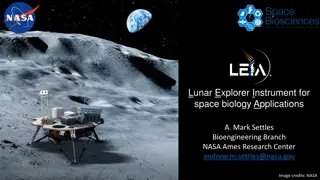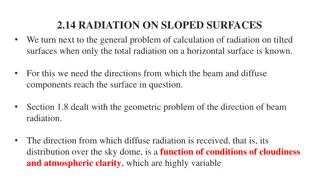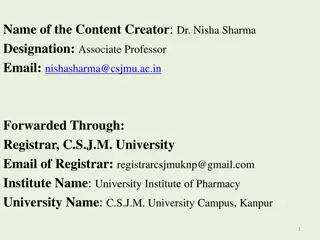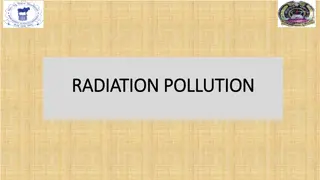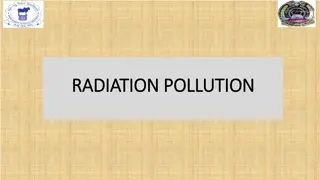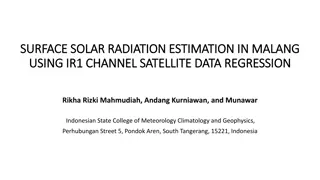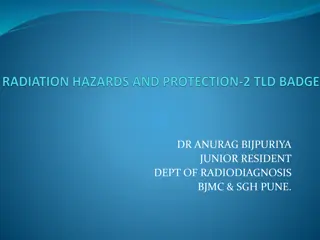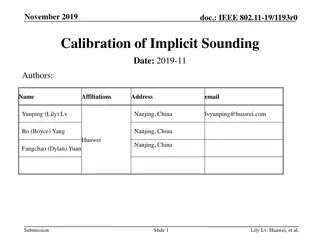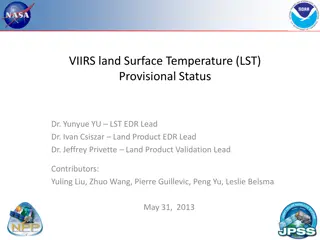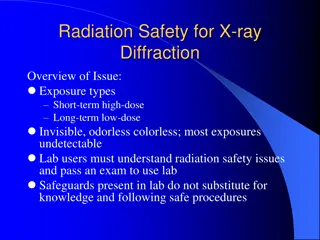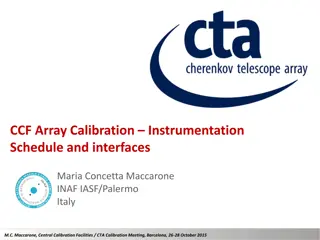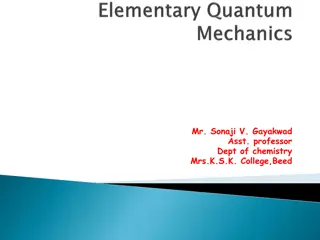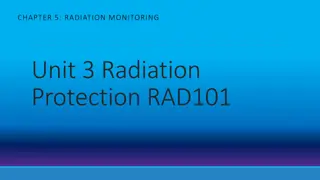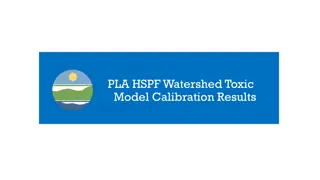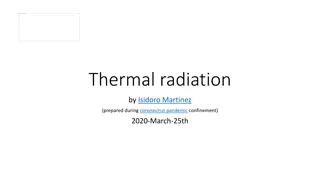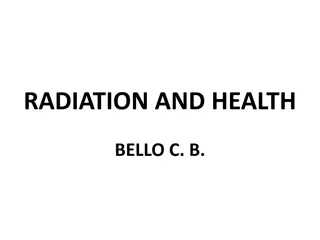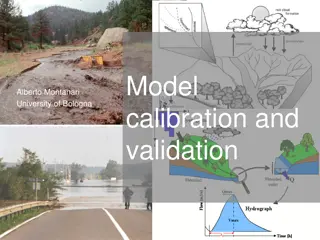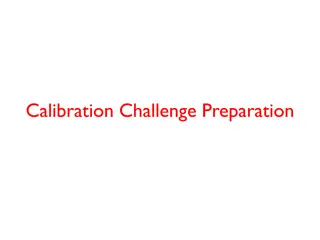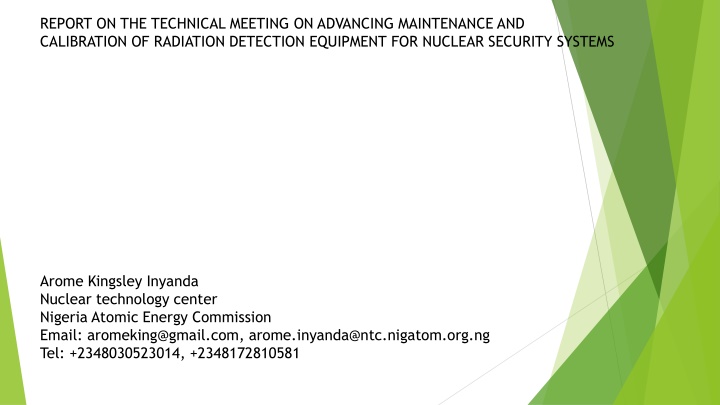
Advancing Maintenance & Calibration of Radiation Detection Equipment
Technical meeting report on enhancing maintenance, repair, & calibration of radiation detection equipment for nuclear security systems. Discussions on best practices, common issues, solutions, & resources.
Download Presentation

Please find below an Image/Link to download the presentation.
The content on the website is provided AS IS for your information and personal use only. It may not be sold, licensed, or shared on other websites without obtaining consent from the author. If you encounter any issues during the download, it is possible that the publisher has removed the file from their server.
You are allowed to download the files provided on this website for personal or commercial use, subject to the condition that they are used lawfully. All files are the property of their respective owners.
The content on the website is provided AS IS for your information and personal use only. It may not be sold, licensed, or shared on other websites without obtaining consent from the author.
E N D
Presentation Transcript
REPORT ON THE TECHNICAL MEETING ON ADVANCING MAINTENANCE AND CALIBRATION OF RADIATION DETECTION EQUIPMENT FOR NUCLEAR SECURITY SYSTEMS Arome Kingsley Inyanda Nuclear technology center Nigeria Atomic Energy Commission Email: aromeking@gmail.com, arome.inyanda@ntc.nigatom.org.ng Tel: +2348030523014, +2348172810581
Presentation outline 1. EXECUTIVE SUMMARY 2. INTRODUCTION 3. OBJECTIVESOF THE TECHNICAL MEETING 4. KEY ISSUES IDENTIFIED DURING PRESENTATIONSBY MEMBER STATES 5. PRELIMINARY SOLUTIONSTO IDENTIFIED ISSUES 6. OTHER RECOMMENDATIONS FOR IAEA 7. CURRENT IAEA SUPPORT OPPORTUNITIES 8. SUPPORT AVAILABLE OUTSIDEOF IAEA 9. CONCLUSION
EXECUTIVE SUMMARY The Technical Meeting on Advancing the Maintenance and Calibration of Radiation Detection Equipment for Nuclear Security Systems was hosted by the Government of Burkina Faso in conjunction with The International Atomic Energy Agency (IAEA) from 6-9th of May, 2019, at Ouagadougou Burkina Faso. Twenty one participants from 12 Member States shared their experience related to the maintenance, repair, and calibration of radiation detection equipment used for nuclear security. The Member States represented were Nigeria, Senegal, Mali, Ghana, Cameroun, Democratic Republic of Congo, Sierra Leone, Benin Republic, Mauritania, Bulgaria, United States of America and the host, Burkina Faso. The IAEA was represented by Tyrone Harris of the Division of Nuclear Security. The goals of the Technical Meeting was for the participants to share best practices, identify and discuss common issues, determine areas where science and technology can improve the effectiveness, efficiency, and sustainability of radiation detection systems.
INTRODUCTION The technical meeting was declared open by the Director Autorit Nationale de Radioprotection et de S ret Nucl aire Mr. Martial ZOUNGRANA. The Director welcomed participants and encouraged members to have a fruitful Meeting. Twenty one participants from 12 Member States shared their experience related to the maintenance, repair, and calibration of radiation detection equipment used for nuclear security. The Member States represented were Nigeria, Senegal, Mali, Ghana, Cameroun, Democratic Republic of Congo, Sierra Leone, Benin Republic, Mauritania, Bulgaria, United States of America and the host, Burkina Faso. The IAEA was represented by Tyrone Harris of the Division of Nuclear Security.
OBJECTIVES OF THE TECHNICAL MEETING The main objectives of the Technical Meeting were: Share best practices in maintenance, repair, and calibration of radiation detection equipment that is used for nuclear security purposes; 1. Identify common issues where science and technology can improve the effectiveness, efficiency, and sustainability of radiation detection systems; 2. Discuss potential solutions to common issues raised by Member States; 3. Propose practical next steps to implement solutions to identified issues; and 4. Discuss existing resources that aid maintenance, repair, and calibration efforts. 5.
KEY ISSUES IDENTIFIED DURING PRESENTATIONS BY MEMBER STATES The following key issues were identified by the participants as causes of extended out of service periods and exorbitant costs. GENERAL The following general issues were identified by participants. Service manuals, circuit diagrams, and other detailed technical, and documentation are not available for some instruments. Instruments that do not have published technical support documents may not be repairable or the repairs require the instrument to be sent outside of the Member State; Insufficient budgeting for maintenance, repair, and calibration activities; Maintenance and repair contracts are often not included in equipment procurements; Insufficient local expertise in maintenance and repair of equipment; and Some Member States have limited access to appropriate calibration facilities. 1. 2. 3. 4. 5. 6.
BATTERIES AND OTHER COMPONENTS Battery failure can cause detection instruments to be unusable for extended periods if: 1. Some instrument experience repeated failure of the same components; 2. High quality or Original Equipment Manufacturer (OEM) replacement batteries or other components are not available for some instruments in some of the Member States; and 3. Instrument design can prevent battery or other component replacement.
PRELIMINARY SOLUTIONS TO IDENTIFIED ISSUES The following solutions were proposed by participants in response to identified issues. Procurement of equipment by IAEA to be used by Member States should be done under a signed technical usage agreement which clearly specifies the operating condition of the equipment, expected performance of equipment and expected duration of use for the equipment. The IAEA and Member States should develop and publish a resource that lists regional suppliers for OEM quality replacement batteries and other necessary components.. The IAEA and Member States should design an equipment management tracking system which includes a maintenance plan and process for tracking implementation of that plan. This resource should aid the member states in both budgeting time and funds and tracking specific activities including: charging of batteries; replacement of batteries; physical inspection; and cleaning. Manufacturers of equipment should determine average maintenance costs for their equipment given certain usage conditions. This will help in planning and budgeting for maintenance of the equipment. The IAEA and Member States should develop a platform through which a network of experts within the region can share experience and solutions to challenges faced during maintenance and calibration of equipment. The IAEA and Member States should develop strong expertise in maintenance of equipment through training, technical meetings, and fellowships. 1. 2. 3. 4. 5. 6.
PRELIMINARY SOLUTIONS TO IDENTIFIED ISSUES The IAEA and Member States should conduct preliminary tests to determine if donated equipment is working according to the specified technical performance requirements before deployment to Member State for use. 7. Customer support contracts should, when appropriate, include technical documentation with electronic schematic diagram, video chat, and remote diagnostic tools. 8. The IAEA should develop RAF or AFRA that will support training and research needed for maintenance engineers working within Africa. 9. The IAEA and Member States should identify and avoid procurement of equipment from vendors with poor or no customer support program or activity. 10. The IAEA could create a platform to keep tract of spare parts needs of Member States with an aim of pooling purchases into bulk orders that reduce costs. 11. Member state should plan and develop procedures for shipping in line with their respective government policy while taking advantage of using ATA CARNET for temporary admission of goods 12.
PRELIMINARY SOLUTIONS TO IDENTIFIED ISSUES 13. The IAEA should communicate with decision makers within the Member States and highlight the need to make adequate budgets to support the maintenance of equipment donated to Member States. Often maintenance costs are around 10% of the cost of the equipment per year. 14. Procurements should be planned on the basis of need and the following considerations: a. Operability b. Usability c. Training available d. Technical Performance i. Detection ii. Identification e. Sustainability i. Instrument design ii. Customer service iii. Life cycle costs 15. A regional approach should be pursued in sharing experiences and facilities for maintenance and calibration. There is need to know the facility available in various states within the region and how the facilities can be accessed to provide solutions to challenges faced by other member states within the region.
OTHER RECOMMENDATIONS FOR IAEA The following additional recommendations were purposed by the participants. 1. The IAEA should host a Technical Meeting at an IAEA laboratory during which participants could address a specific maintenance, repair, or calibration issue while repairs and maintenance of selected equipment are performed by qualified IAEA technical partners. Participants would hand carry the specified equipment to the meeting. 2. The IAEA should develop an online network where Member States can record maintenance issues and provide feedback. 3. The IAEA should develop maintenance agreements with vendors and determine how long the vendor will support the maintenance of the equipment.
CURRENT IAEA SUPPORT OPPORTUNITIES The IAEA supports collaboration opportunities via the International Network for Nuclear Security Training and Support Centres (NSSCs) and Coordinated Research Project (CRPs). The Agency supports research work on providing solutions to nuclear security detection equipment challenges and also building capacity that is sustainable. Below are some of the opportunities: 1. EXPERTWORKINGGROUPACTIVITIESFORTESTPLANDEVELOPMENTANDIMPLEMENTATIONFOR RADIATIONDETECTIONEQUIPMENT. 2. COORDINATED RESEARCH PROJECTON IMPROVED ASSESSMENTOF INITIAL ALARMSFROM RADIATION DETECTION INSTRUMENTS.
CURRENT IAEA SUPPORT OPPORTUNITIES 1. COORDINATED RESEARCH PROJECTON ADVANCING RADIATION DETECTION EQUIPMENTFOR DETECTING NUCLEARANDOTHER RADIOACTIVE MATERIALOUTSIDEOF REGULATORY CONTROL. 2. COORDINATED RESEARCH PROJECTON ADVANCING MAINTENANCE, REPAIR, AND CALIBRATIONOF RADIATION DETECTION EQUIPMENT. 3. PLANNED COORDINATED RESEARCH PROJECTON CYBER SECURITY ISSUESWITH DETECTION ACTIVITIES ASSOCIATEDWITH MATERIAL OUTSIDEOF REGULATORY CONTROL (INMA & MORC). 4. PLANNED COORDINATED RESEARCH PROJECTON ACTIVEAND INTEGRATED SYSTEMAND USEOF NUCLEAR INTERROGATION TECHNIQUESFOR CONTRABAND. 5. ONGOINGPROJECTTODEVELOPAN ADVANCE INTEGRATED NUCLEAR SECURITY NETWORK (INSN).
SUPPORT AVAILABLE OUTSIDE OF IAEA During the meeting, participants were granted access to The Office of Nuclear Smuggling Detection and Deterrence (NSDD) Knowledge Management Website (KMW). The website feature the following tools and programs: 1. Troubleshooting Guides 2. Maintenance Guides 3. Equipment Specs 4. Routine/Corrective Action Check Lists 5. Maintenance Training 6. Software Tools (MCAAW, HATS, FCT, COMMON, DART) 7. NSDD Help-Desk 8. NSDD Portal (Routine/Corrective Maintenance Reports)
C CONCLUSION ONCLUSION The participants extensively discussed issues and offered professional solutions to challenges related to repair, maintenance and calibration of radiation detection equipment that is used for nuclear security purposes. Plans were made to further develop proposals for projects that will offer workable solutions to the identified issues.

